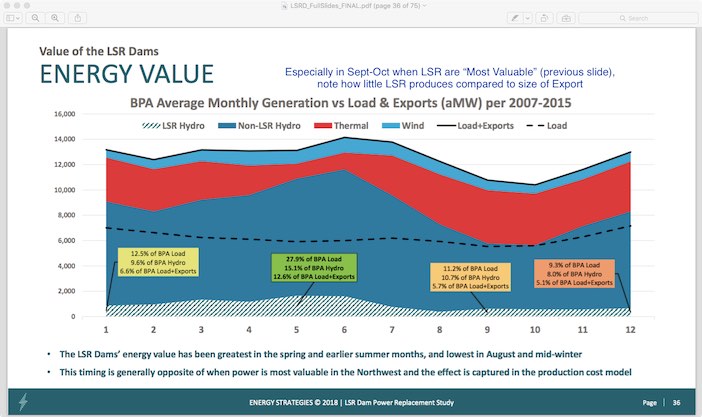forum
library
tutorial
contact

The Snake River Dams Fill a Power Gap.
Lawmakers Need to Know That
by Editorial Board
Tri-City Herald, January 30, 2019
|
the film forum library tutorial contact |

|
The Snake River Dams Fill a Power Gap.
by Editorial Board
|
But a switch can be flipped and the region can get the extra electricity
it needs thanks to the hydropower system and the Snake River dams.
 Saying we don't need the four lower Snake River dams because they generate just a small percentage of the region's electricity is a bit like saying the Seattle Mariners don't need relief pitchers who are in the game for only an inning or two.
Saying we don't need the four lower Snake River dams because they generate just a small percentage of the region's electricity is a bit like saying the Seattle Mariners don't need relief pitchers who are in the game for only an inning or two.
The dams, like a closing pitcher, are needed for their reliability and to fill in during critical times.
As lawmakers consider Gov. Jay Inslee's proposal to make Washington 100 percent carbon free, we hope they grasp the role hydropower plays in providing clean, renewable, low-cost power to the region.
We also hope they come to understand the essential role the Snake River dams play in the power-generating system.
On Tuesday, Sen. Sharon Brown, R-Kennewick, tried to protect the Snake River dams in the Senate Energy, Environment and Technology Committee, but her attempt was instantly shot down.
The committee was discussing Senate Bill 5116, the clean energy bill Inslee is pushing, and Brown tried to attach an amendment that opposed breaching or removing any dam on the Columbia and Snake rivers.
Her proposed language said the dams are of "paramount importance" for the "security and prosperity of the state," and acknowledged their necessity to hydroelectric power generation. But few supported Brown's effort.
The committee ended up approving the measure along party lines and it now moves to the Senate Ways and Means Committee. Brown was among the Republicans who opposed it.
She told the Herald she believes in an "all of the above" approach to attaining 100 percent clean energy, and that means including hydropower and nuclear power in the mix. Brown said SB 5116 is "fuzzy" on nuclear power and that it does not go far enough to protect the hydropower system.
Anti-dam activists want the Snake River dams gone in order to improve salmon runs, and their message is gaining momentum on the west side of the state.
We also want to see fish runs improve, but taking out the dams is an extreme position.
Others, however, don't agree. One of their main arguments is that the power generated by the four dams could easily be replaced by wind and solar energy.
That claim is not true, according to several people who understand how the region's power system works.
Representatives from the Benton and Franklin PUDs, the Tri-City Development Council and the Port of Pasco recently met with the Tri-City Herald editorial board to stress that the Snake River dams are primarily needed for reserve power.
And that's crucial when there are long stretches of extreme temperatures in the region. Chad Bartram, Benton PUD general manager, said the wind tends not to blow when it is really cold and when it is really hot -- just when you need power the most.
But a switch can be flipped and the region can get the extra electricity it needs thanks to the hydropower system and the Snake River dams.
Backing up this assertion is the Public Generating Pool, which just released a study showing it would be too expensive and impractical to replace reliable power sources with solar and wind. The PGP is an association composed of consumer-owned electric utilities from Washington and Oregon who work together on common issues.
In preparation for the push for 100 percent clean energy, the group wanted to find out how power can be served to the Northwest under a carbon-reduction scenario in 2030 and 2050.
The study found that 3 million to 14 million acres -- or 100 times the land mass of Portland and Seattle combined -- would be needed to support the wind and solar production required. It is unclear whether there are even enough sites suitable for that level of development, the study said.
And that doesn't include the extra miles of transmission lines that would be needed.
Energy storage also is an issue with wind and solar because the technology is still limited. Batteries last 4 to 10 hours and then need to be recharged. If the weather does not cooperate for several days, that's a problem.
Wind and solar energy are important pieces to attaining more clean energy in the state, but they can't replace the reliability of hydroelectricity.
Brown's push to make sure all carbon-free power sources are included in Inslee's plan is spot on, and we hope more of her fellow legislators will come to understand that.
Related Pages:
Stories on Salmon Too Often Skewed by John L. Cox, Tri-City Herald, 9/13/18
Editorial Board
The Snake River Dams Fill a Power Gap. Lawmakers Need to Know That
Tri-City Herald, January 30, 2019
learn more on topics covered in the film
see the video
read the script
learn the songs
discussion forum
